1lumen selects and reviews products personally. We may earn affiliate commissions through our links, which help support our testing.
Manker E02 II review
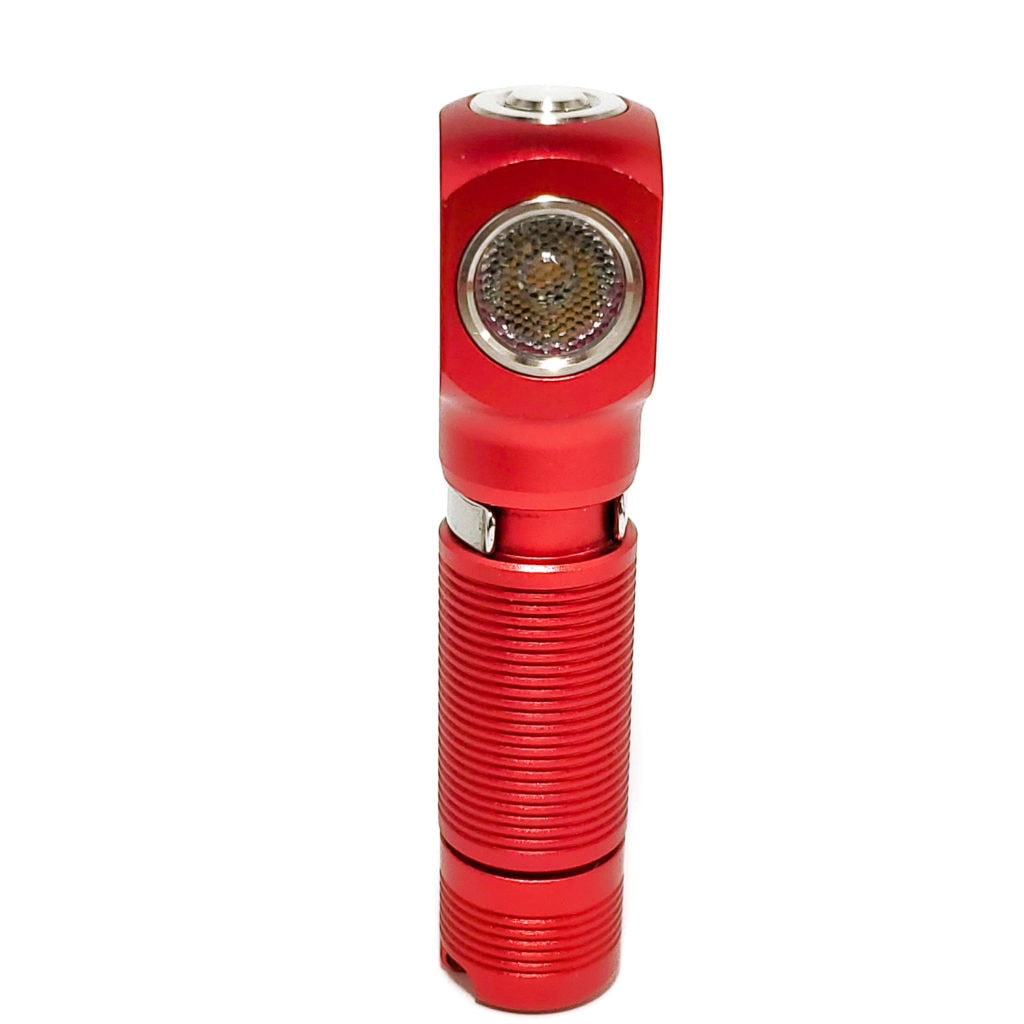
Manker E02 II specifications
| Brand/model | Manker E02 II |
|---|---|
| Category | right angle flashlight |
| LED | Luminus SST20 4000K |
| Max. Lumens | 420 lm |
| Max. Beam intensity / distance | 1,300 cd |
| Battery config. | 1*10440 / AAA |
| Onboard charging | N/A |
| Modes | 8 |
| Blinkies | Strobe |
| Reflector | Strobe |
| Waterproof | IPX8 |
| Review date | June 2022 |
Introduction:
The Manker E02 II is one of the smallest right-angle lights you can buy, and one of my favorite lights! This light is the smaller, AAA sized sibling to the E03H II and shares many features with it. For version II of these lights, Manker went with the Luminus SST20 and added Li-ion support for additional fuel options and higher output.
The E02 II’s small size allows it to slip easily into your pocket, onto a keychain, or be clipped almost anywhere!
Package quality.
This light comes in a small tin, about the size of an Altoids tin, topped with a sticker containing basic specs on the light such as lumens and runtime. The body color and light temperature are manually checked off. The light is nestled in a shaped cutout in a foam insert.
Inside the tin, you’ll find:
- The Manker E02II with clip attached
- Instruction manual
- Spare o-ring
- Split keyring
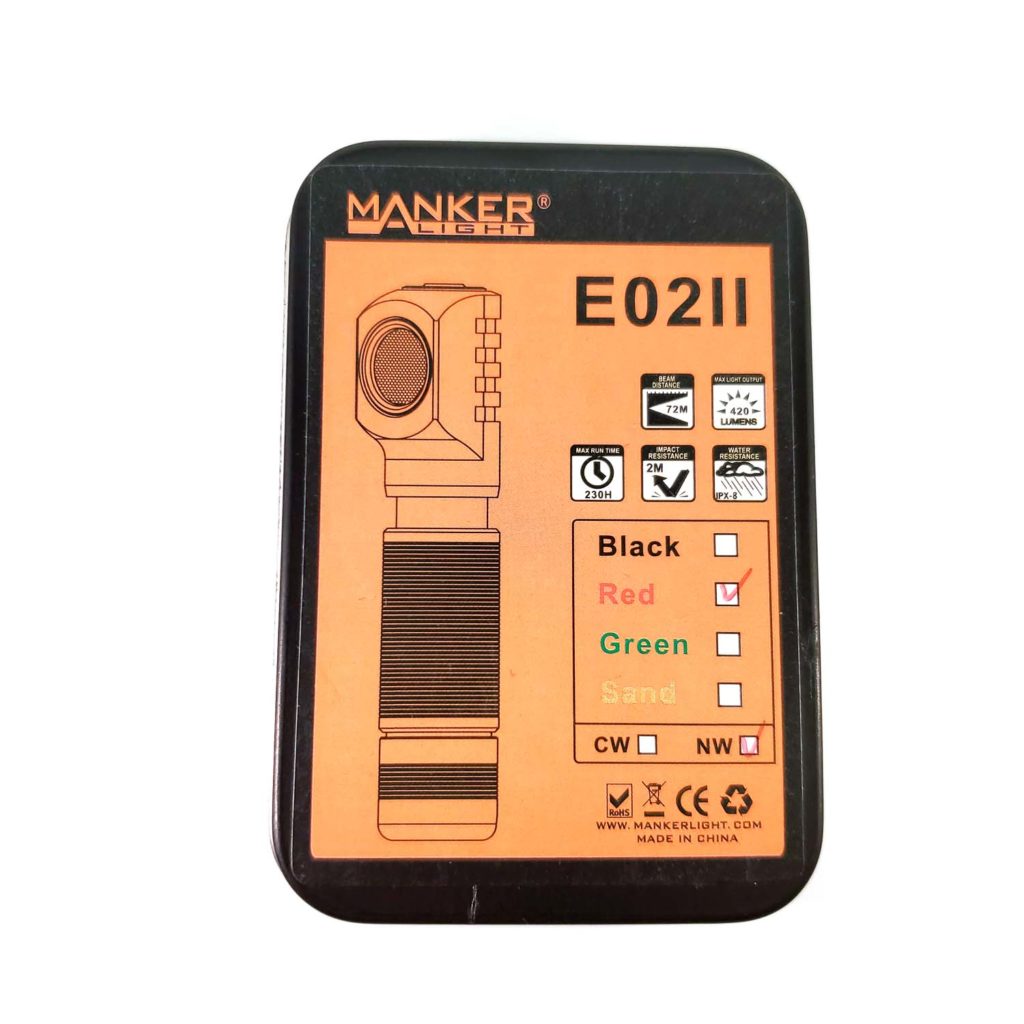
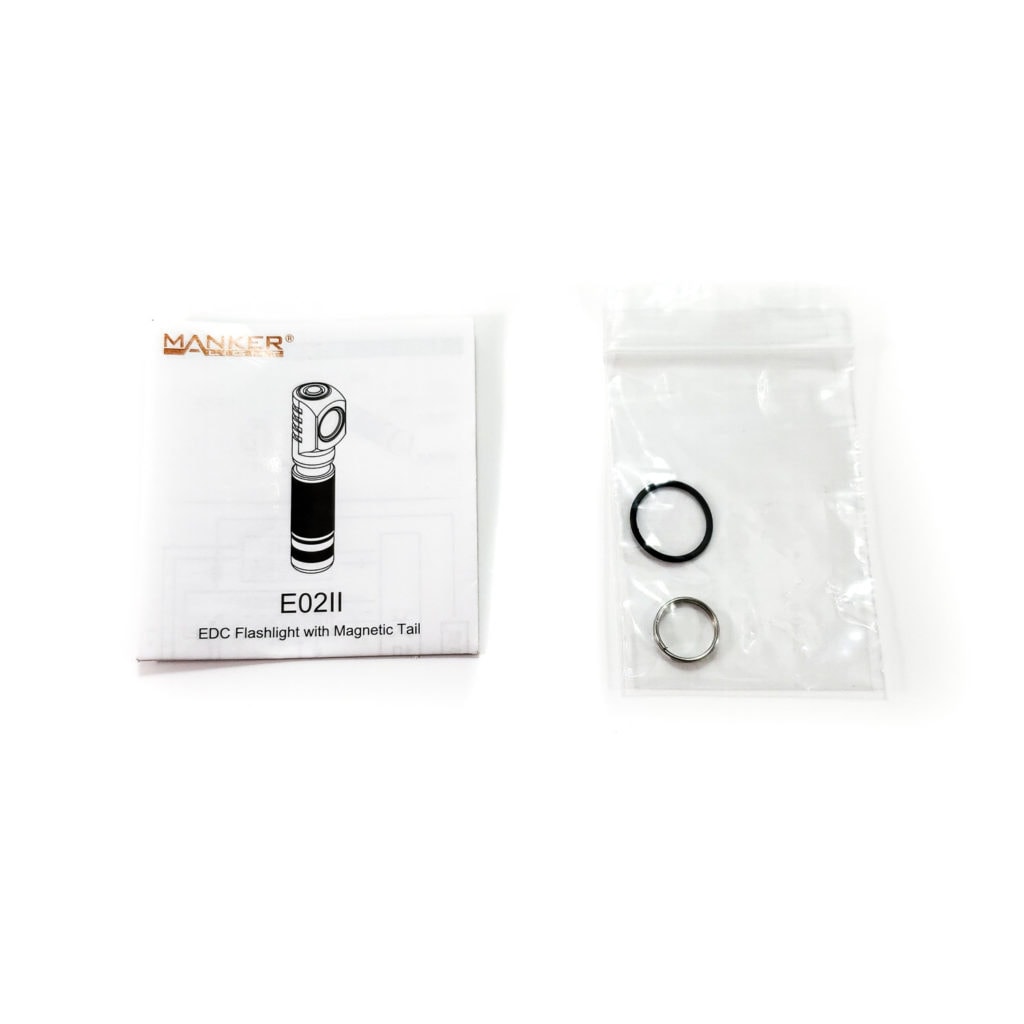
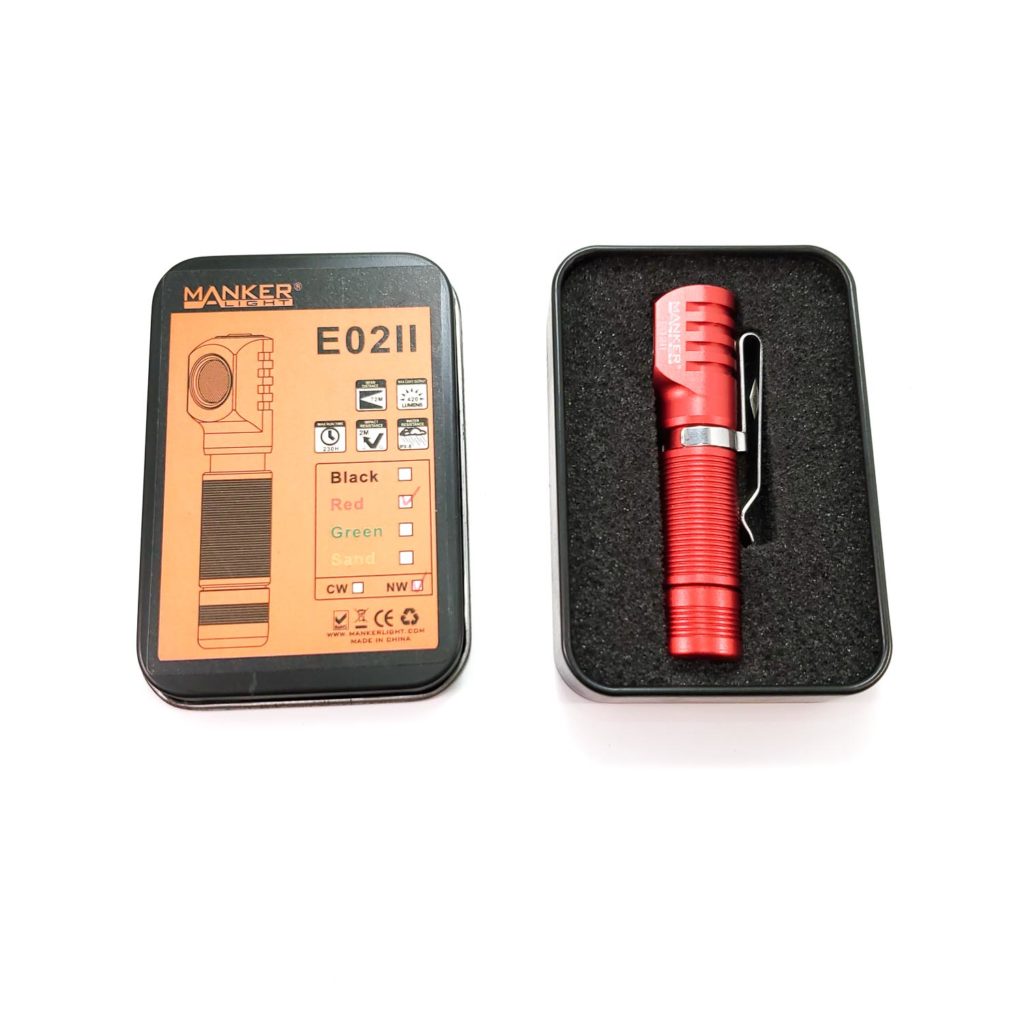
Flashlight in use
Being an AAA-sized light, the Manker E02 II is very small. This allows it to slip, or clip, unnoticed into your pocket or bag for everyday carry. There are many ways you can use this light, too; in addition to holding it in your hand, the magnet in the tailcap is strong enough to hold it perpendicular to, or even hang it from a ferrous surface, allowing you to aim the light in whichever direction you please.
Not only that, but it’s light enough that you can use the included deep carry clip to clip it to a shirt pocket or strap for on-the-go illumination. The clip hugs the light securely but is loose enough to swivel around which also allows you to point it in almost any direction you need.
There’s also an included split ring to put the light on a keychain, if you so desire. I would think you’d want to put it on a clip (S-biner or the like) and clip that to your key ring for easy removal if you want to carry it that way.
Manker does offer a headband for the E02 II, but it’s sold separately and I do not have one to evaluate.
There is no tripod mount option.
While the Manker E02 II is good for EDC, I feel like its best use is in near-total dark places where you want to avoid bothering others. The extremely low Eco modes make this an excellent bedside light or to take along when stargazing. Because it only has so much output, especially with AAA batteries, it may not be ideal as a primary outdoors light but could serve as a backup. Since it’s so small, you could clip it to a pet’s collar or harness to use as a beacon while taking a nighttime walk.
You will want to lock this light out if you clip it to your pocket as having the button on top makes it the most accidentally activated light I own.
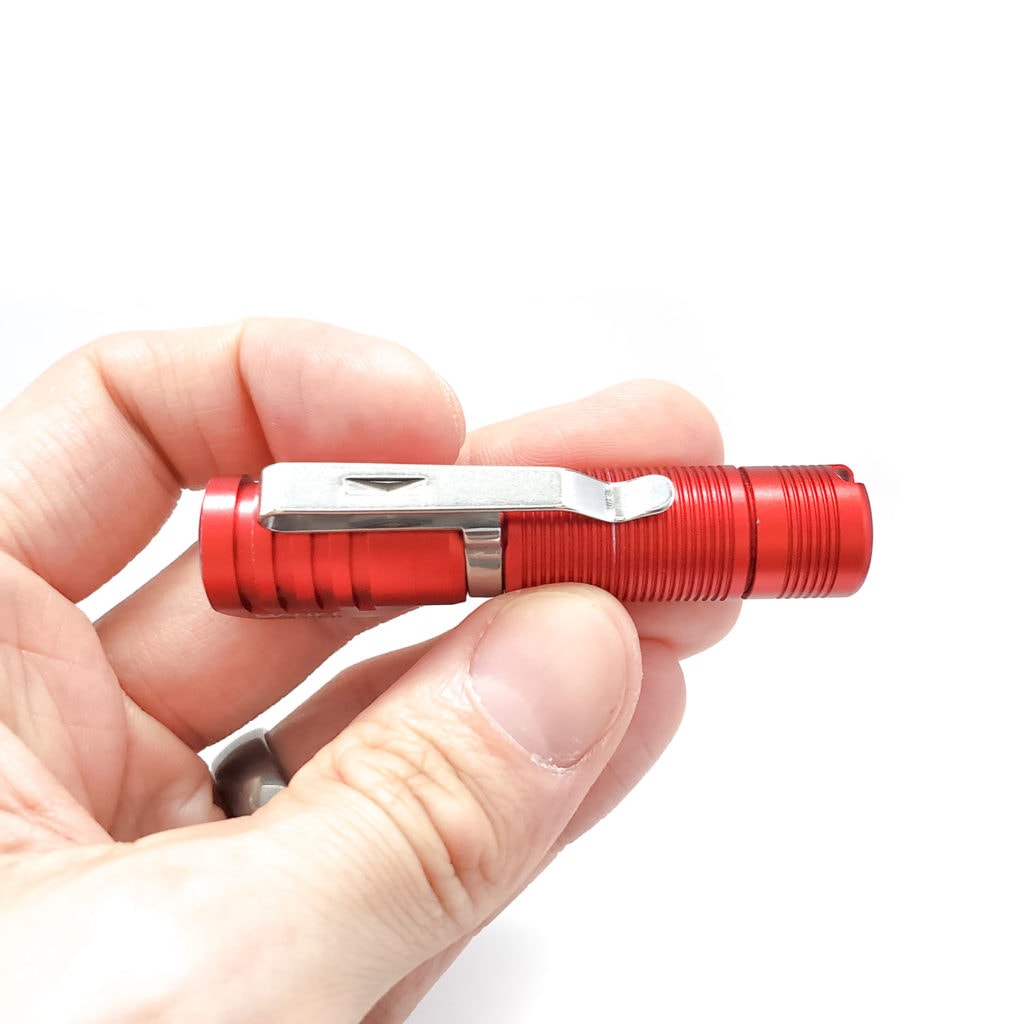
Build Quality, and Warranty
The Manker E02 II has a fairly standard right-angle light design, with the driver, emitter, and button above the battery. It has some cooling fins on the head and only horizontal knurling on the body and tailcap. This is important to note because if your fingers are applying pressure vertically against the body, you can hold it fine, but if that pressure is horizontal, the light can easily slip from your hand. This is one of my few issues with the light, as I’ve ended up fumbling it more than I’d like to admit.
This light only comes in aluminum, but you can choose from black, red, green, or sand colored, type-III, glossy anodization.
While the body is actually three parts; head, tube, and tailcap; the head is glued onto the tube and not removable under normal circumstances. There are o-rings at both ends of the tube, the TIR is press fit, and the button has a rubber gasket under it, all of which contribute to its IPX-8 rating. On the right side of the head is the Mankerlight logo and model name, and on the left side are some regulatory symbols and the serial number. I believe they’re laser etched in. There are no other markings.
The magnet in the tailcap is strong enough to hold this tiny light at a 90-degree angle, but if you don’t want that, it’s removable, too. When you take the tail cap off, you can squeeze the base of the spring, which is a V shape and held at three points under a lip, and remove it. The magnet is not glued in, and will then fall out if you tip it upside-down.
The friction clip comes attached, but can be pulled off if necessary. I have not done this on purpose or by accident since getting this light, despite always clipping it onto my front pants pocket for carry. Interestingly, unlike most clips, the arms wrap around the body enough to hold it on, but they don’t grip it tightly, as mentioned above. It’s also nice that the clip allows for deep carry. The clip can be reversed, but there is only one groove in which it will fit (by the head) and so it would not be deep carry if used in that manner. Sliding the clip from side to side has only scuffed around the arms, but it has scratched the knurling.
The E02 II is covered by Manker’s standard 5-year warranty, copied from their site:
Mankerlight provide high-end products and intimate 5 Years warranty service to dealers and end users.
Warranty Details:
Mankerlight provides easy, reliable, speedy service to all lights under our warranty. Dealers will be responsible for customers.
1. Please contact the dealer for replacement if you experience any problem with Manker product within 15 days.
2. The dealer will offer free repairment service or replace the flashlight with the same or similar model if Mankerlight flashlight fails during normal use within a period of 5 years.
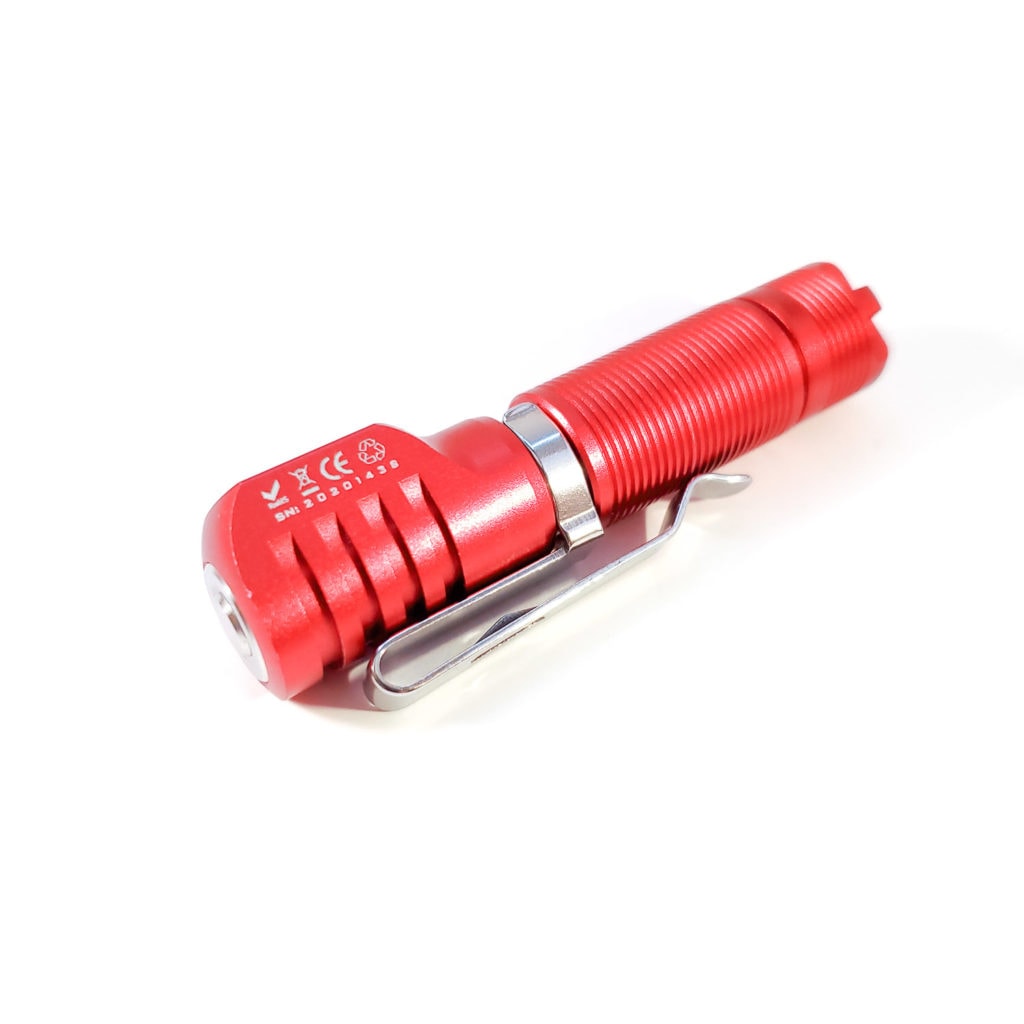
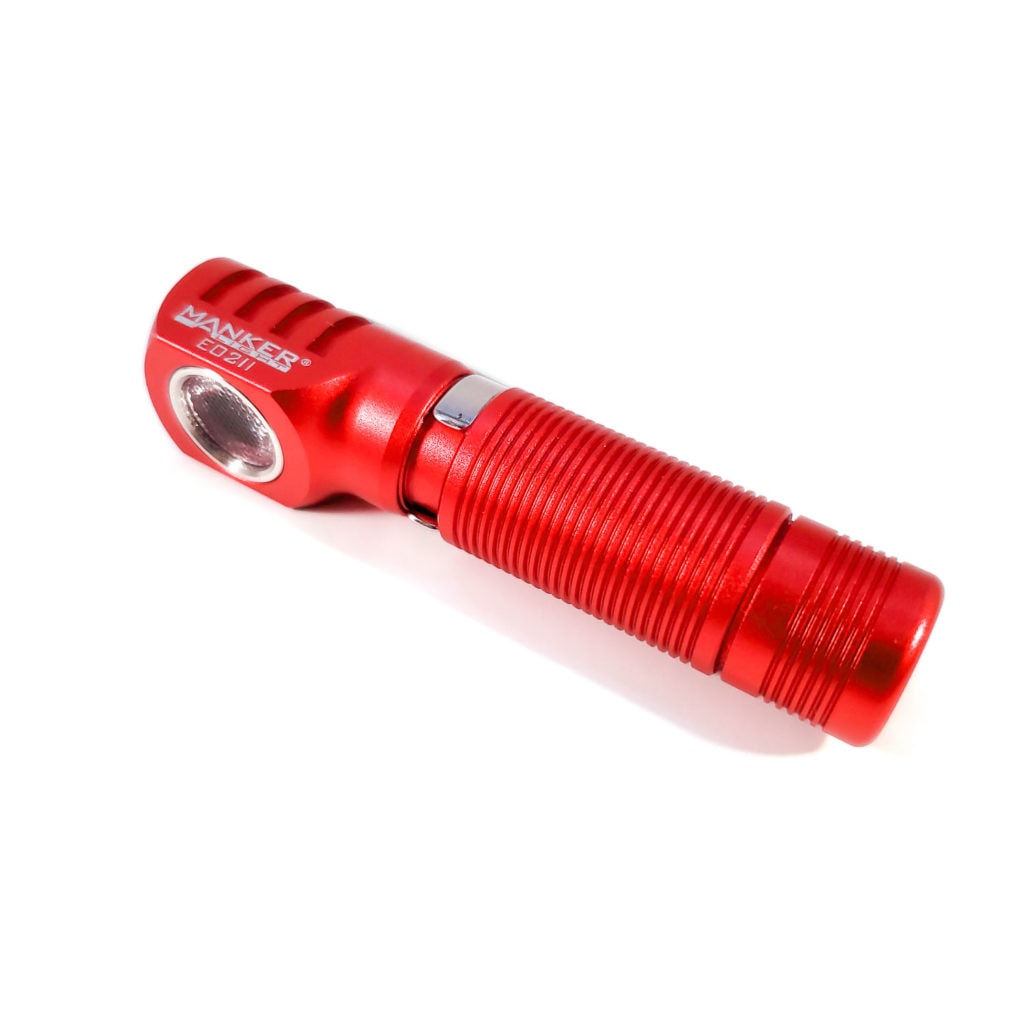
LED, Lens, Bezel, Beam, and Reflector
For the E02 II and E03H II, Maker used the Luminus SST20 in either neutral white (4000K), or cool white (6500K). The SST20 4000K is 95 CRI and has a very pleasant tint to it. I would have to say it’s more on the yellow side, though I do not have instruments to measure DUV at this time, nor do I know the binning Manker used.
The pebbled TIR lens is made from PMMA, as is fairly standard, but there is no glass lens to cover it so that exposure could lead to scratches, though I have not experienced that. The TIR is press-fit into the head with a small stainless steel bezel and is not easily removed.
The beam on this light has a nice, even flood with no hotspot. If you look closely, you will see artifacting around the edges due to the hard (though tiny) angles of the hexagonal pebbling of the TIR optic. It does not detract from the beam at distance, but as you get closer to your intended target (a wall, for example) on, the artifacts become much more visible. Eco 1-4 with AAA batteries are low enough that even up close it’s more difficult to make out the artifacting.
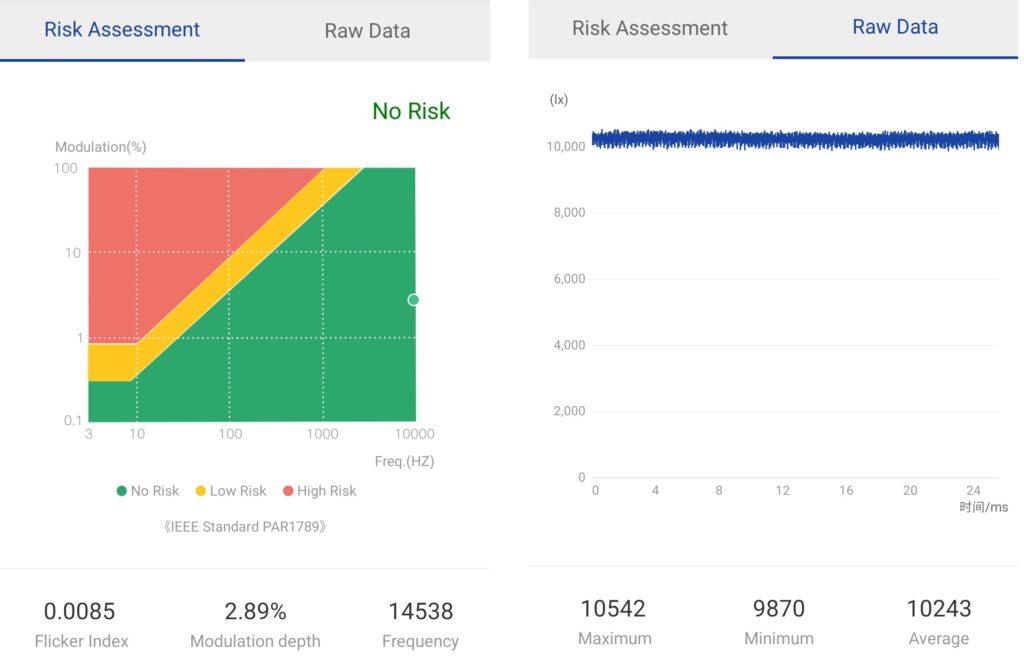
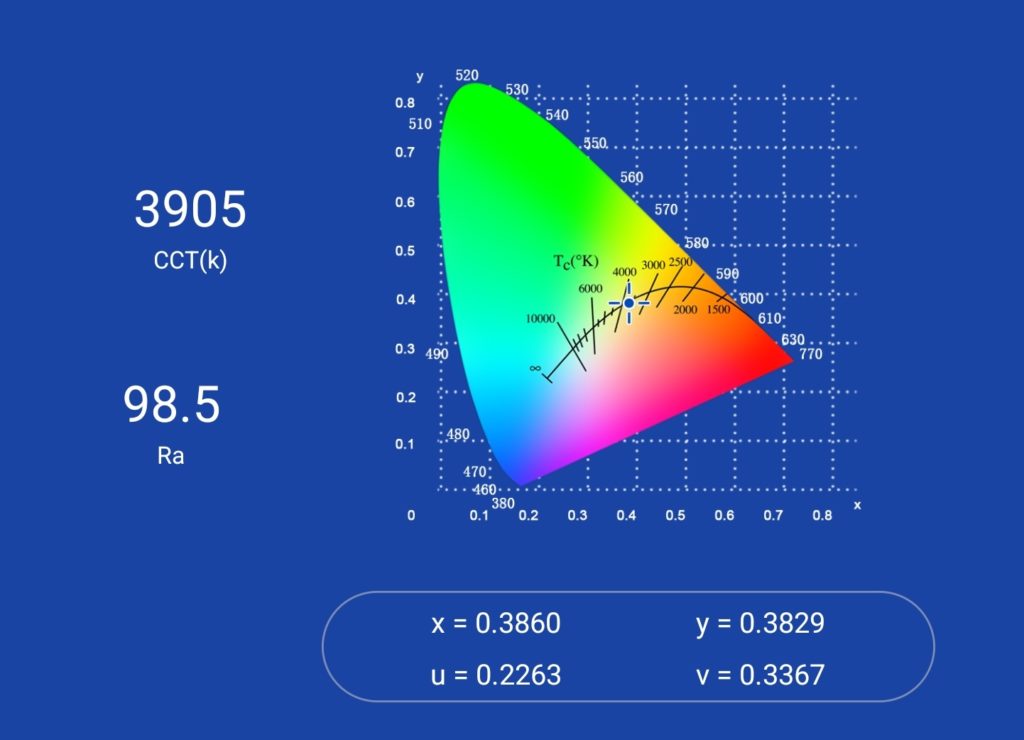
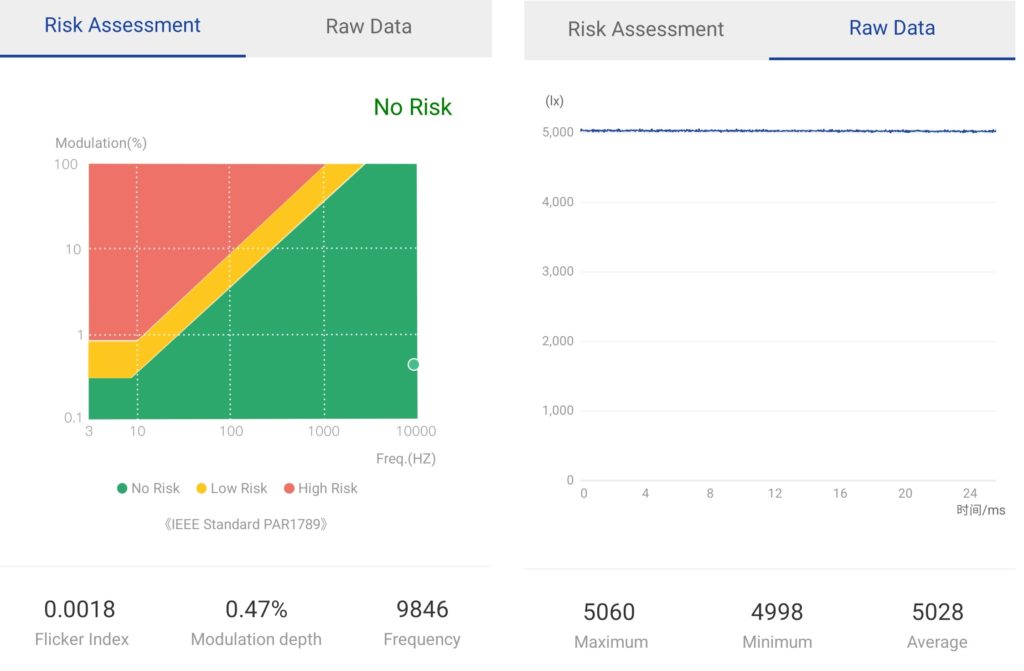
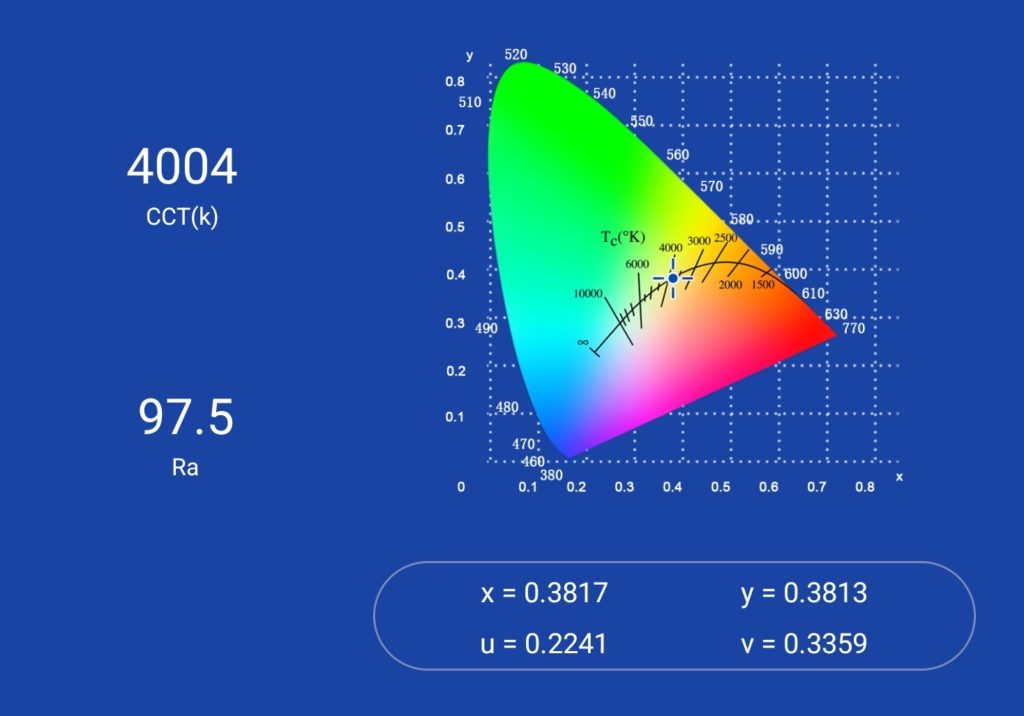
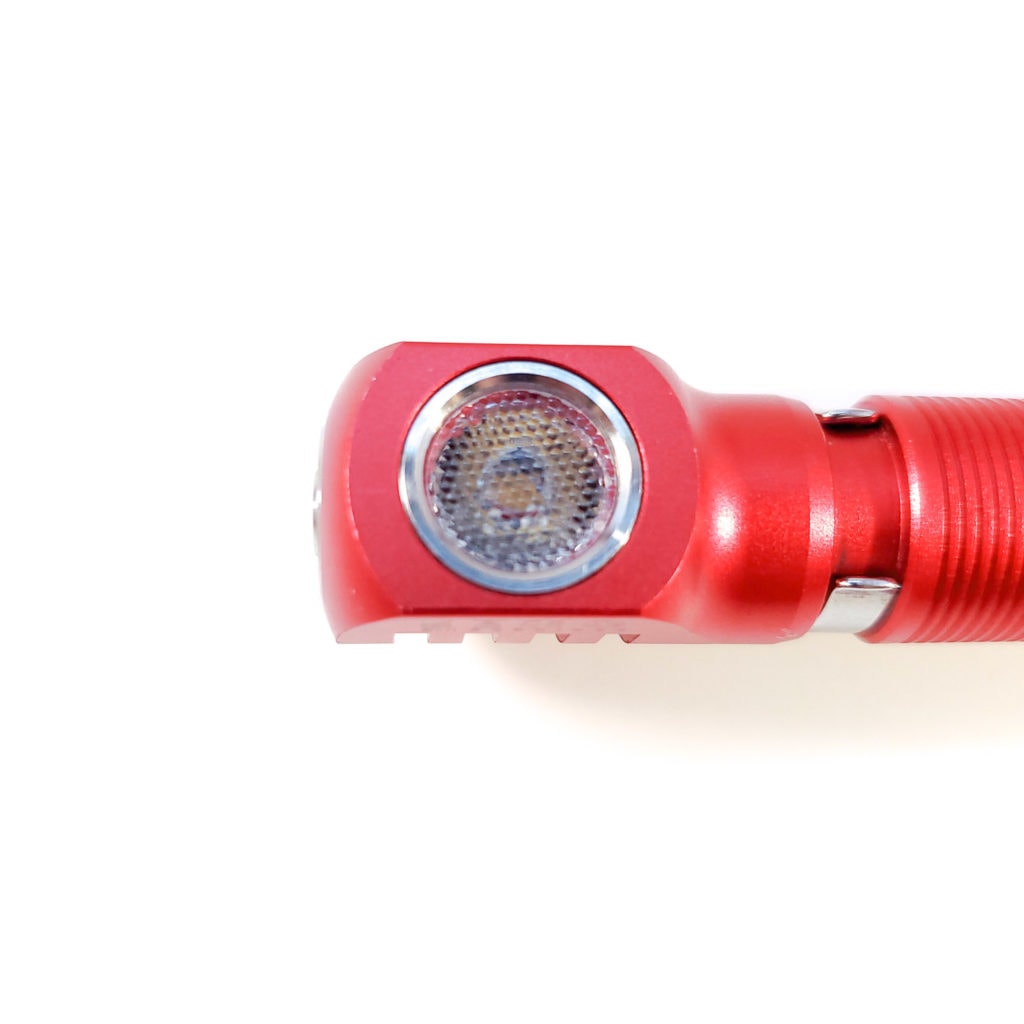
Dimensions and size comparison
Dimensions:
| Manker E02 II | Millimeters | Inches |
|---|---|---|
| Length | 72.6 | 2.86 |
| Head diameter | 19.2 | 0.76 |
| Body diameter | 15.3 | 0.60 |
Weight:
| Manker E02 II | Weight in grams | Weight in Oz. |
|---|---|---|
| Without battery: | 21.2 | 0.83 |
| With battery | 36 | 1.2 |
Flashlight size comparison with its competition:
Left to right: Lumintop GT Nano, Olight Perun Mini, Manker E02 II, Manker E03H II, Emisar DW4 with 18350 tube.
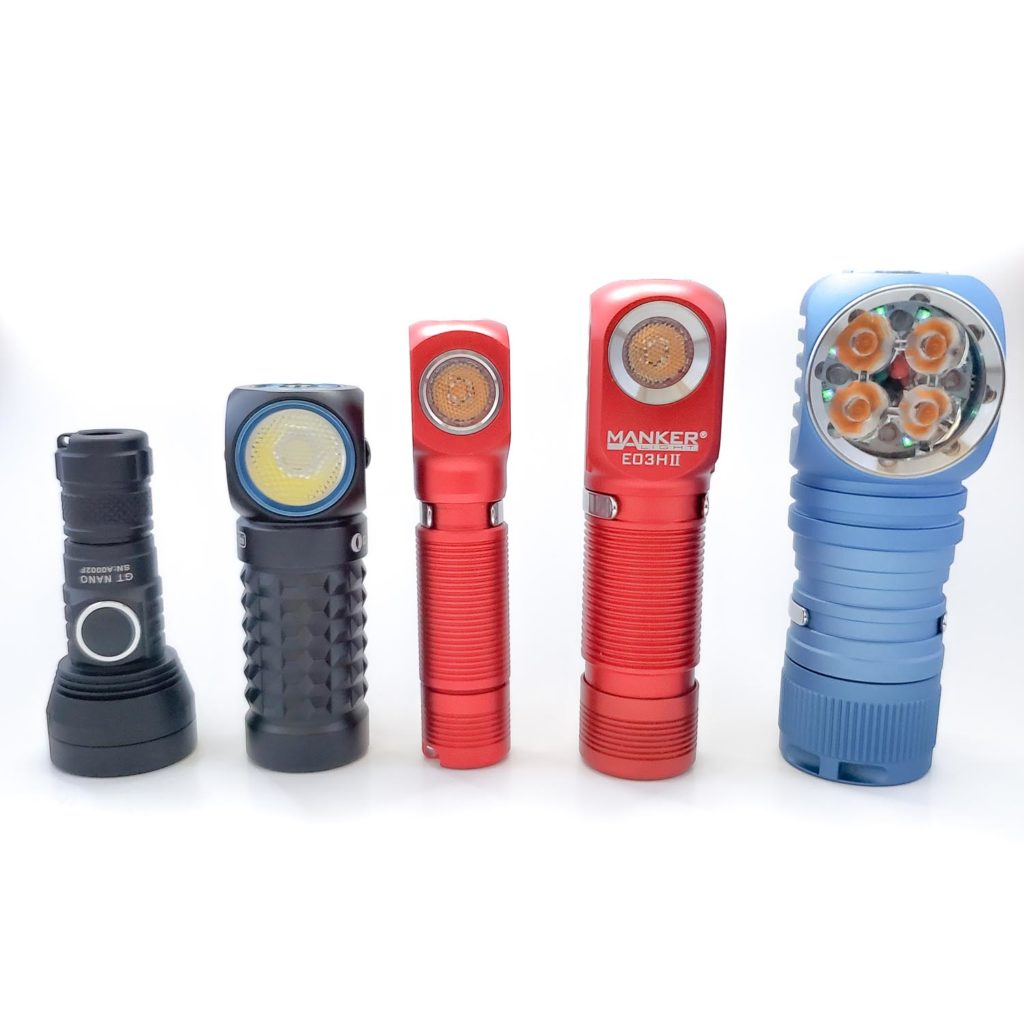
Driver & User Interface:
Available modes:
There are two mode groups: General and Eco. General is medium and high, while Eco is moonlight to low. Each of these are independent of the other and you cannot switch between them without turning the light off and back on. Strobe is not part of the main groups, which is something most people like.
From OFF:
- Press and hold: Memorized Eco mode
- Single click: Memorized General mode
- Double click: Turbo
- 3 clicks: Strobe
- 4 clicks: Lock out
From ON:
- Press and hold: Cycle through modes (either Eco or General)
- 1 click: Turn off
- Double click: Turbo
- 3 clicks: Strobe
Mode memory:
- Yes, but separate between Eco and General
Shortcuts:
- To Low: Hold for memorized Eco mode
- To Turbo: Double-click
- To Strobe: Triple-click
Low voltage warning:
- AAA – The light just shuts off.
- 10440 – The light will drop down to a very low level before eventually turning off.
Strobe/blinkies
- One unconfigurable strobe
Lock-out mode:
- You can activate electronic lock out using 4 clicks from off, but I find it’s easier and quicker to just loosen the tailcap. Plus, with lockout being 4 clicks and 3 clicks being strobe, sometimes you end up in strobe instead of locking it out.
PWM
- None visible to the naked eye or with a phone’s camera.
Additional info on the UI:
- If you’re using a Li-ion 10440 battery, you’ll only have 5 available Eco modes, instead of the 6 you have with AAA.
Batteries & Charging
The Manker E02 II can take either a 10440 button top or AAA, alkaline or rechargeable. It does not have any onboard charging.
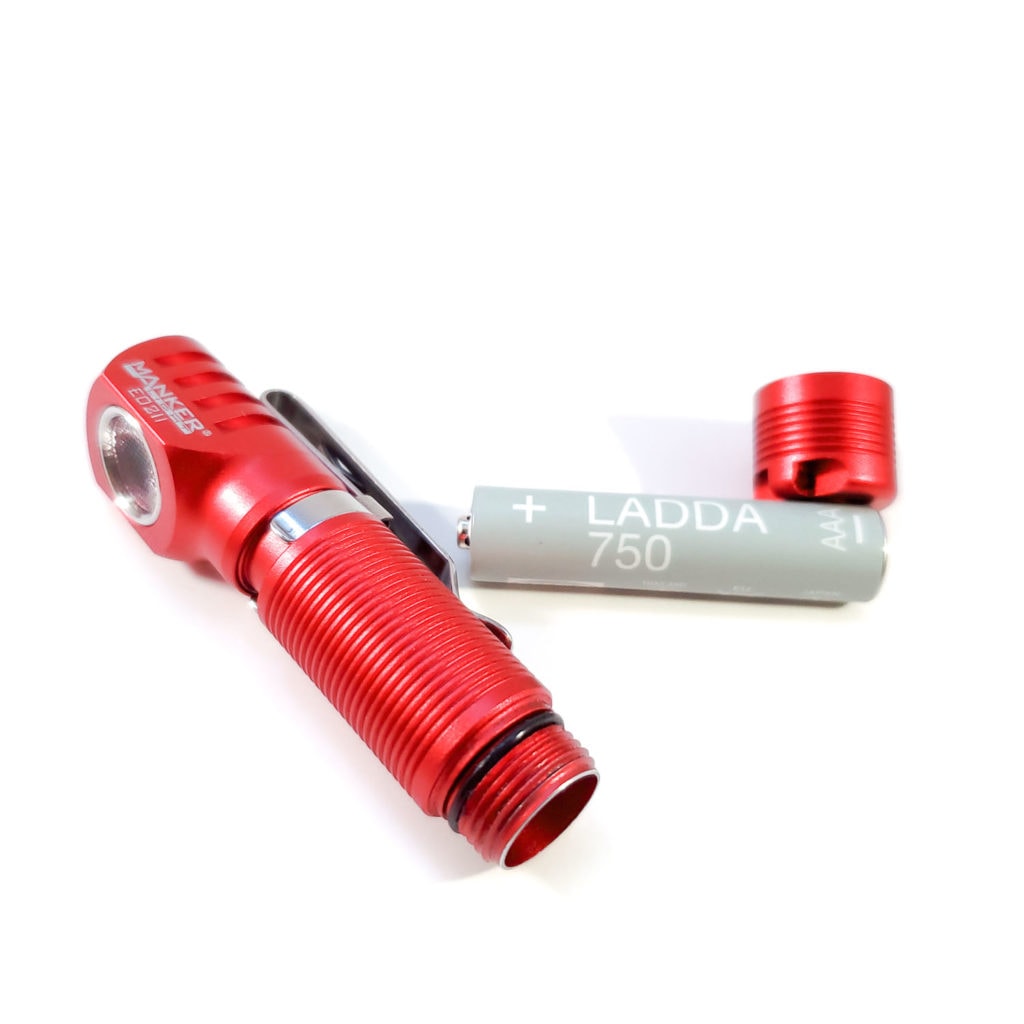
Performance test
To obtain these numbers, I used a very rudimentary integrated shoebox and ceilingbounce on my Samsung Galaxy S10. Ceilingbounce has been calibrated to match the specs of the Baton 3 as provided by Olight and corroborated with other reviewers.
Of importance to note about this light is that the specs provided by Manker are for the cool white version of this light, while I am reviewing the neutral white version. While I do not have a cool white E02 II, I have tested both versions of the E03H II and found the cool white version to match the published specifications, so I feel it would be safe to assume the cool white E02 II matches its published specifications as well.
The 10440 Eco mode spacing leaves a little to be desired, but if you’re going for lower output, you’re going to be using a AAA anyway. When it’s pitch black, the Eco modes with a AAA are nice, offering surprisingly different levels of light when your eyes are adjusted to darkness. I personally tend to use Eco 3 or 4 when walking around the house at night, and I’ve left it on Eco 1 all night as kind of a beacon/night light.
Note that the output with a AAA battery is regulated, while it is unregulated when using a 10440 Li-ion battery. That means that if you use a AAA, you will always have the same amount of light in any given mode until it shuts off at 1.2v, while with a lithium ion battery, the output drops as the voltage drops until it shuts off at 3.15v.
Amps were measured with a Cen-Tech digital multimeter to the best of my ability.
Lumen measurements (for each mode)
AAA – Ladda 750mAh NiMH
| Mode | Amps at start | Specs | turn on | 30 sec | 10 minutes |
|---|---|---|---|---|---|
| Eco – 1 | 0.01 | 0.1 | 0 | 0 | 0 |
| Eco – 2 | 0.01 | – | 0 | 0 | 0 |
| Eco – 3 | 0.01 | – | 0 | 0 | 0 |
| Eco – 4 | 0.01 | – | 0 | 0 | 0 |
| Eco – 5 | 0.02 | – | 0 | 0 | 0 |
| Eco – 6 | 0.06 | – | 6 | 6 | 6 |
| General – Med | 0.20 | 30 | 23 lm | 23 lm | 22 lm |
| General – High | 0.69 | 90 | 71 lm | 71 lm | 69 lm |
| Turbo | 0.91 | 220 | 159 lm | 159 lm | 71 lm |
(Edit: Nov 2022: lumen table updated after applying new correction factor)
10440 – Vapcell 320mAh 3A, green wrapper
| Mode | Amps at start | Specs | turn on | 30 sec | 10 minutes |
|---|---|---|---|---|---|
| Eco – 1 | 0.04 | 5 | 5 lm | 5 lm | 5 lm |
| Eco – 2 | 0.09 | – | 15 lm | 15 lm | 14 lm |
| Eco – 3 | 0.13 | – | 22 lm | 21 lm | 21 lm |
| Eco – 4 | 0.16 | – | 28 lm | 27 lm | 26 lm |
| Eco – 5 | 0.19 | – | 35 lm | 34 lm | 32 lm |
| General – Med | 0.35 | 90 | 65 lm | 62 lm | 57 lm |
| General – High | 0.73 | 220 | 155 lm | 152 lm | 126 lm |
| Turbo | 1.03 | 420 | 319 lm | 280 lm | 126 lm |
(Edit: Nov 2022: lumen table updated after applying new correction factor)
Parasitic drain:
- 0.00 A
Runtime graph
I’ve measured the general modes with both AAA and 10440 batteries, as those are the ones you’ll most be concerned about runtime with. When you get into the Eco modes, you’d be looking at a very long graph, with the lowest AAA mode lasting 8 or so days.
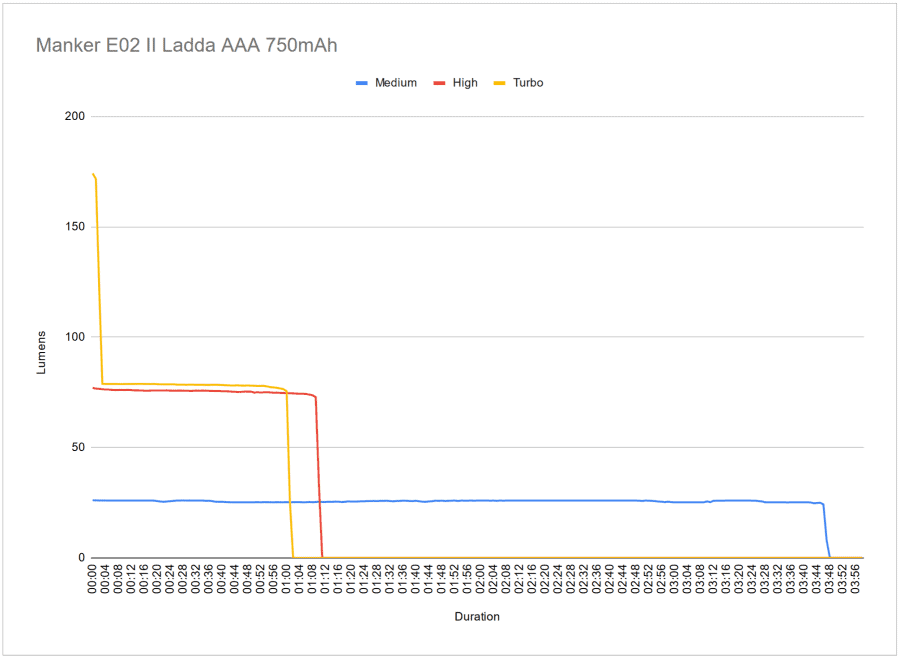
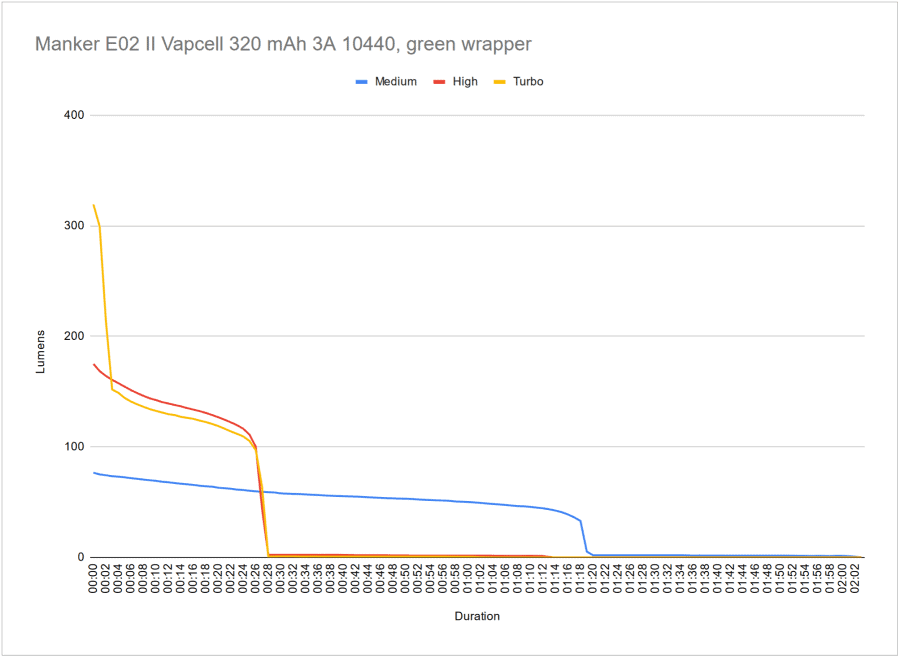
My assumption on why the AAA runtimes don’t meet the specifications is that the 750mAh battery I used has less capacity than what was used for the official specs, which may be alkaline.
With the Vapcell, it interestingly misses the turbo and high ANSI runtime, but exceeds them for medium and Eco 1.
AAA – Ladda 750mAh NiMH
| Mode | Specified | Measured runtime ANSI | Time till shut off |
|---|---|---|---|
| Eco – 1 | 230h | ~8 days | ~8 days |
| General – Med | 5h 30min | 3h 47min | 3h 47min |
| General – High | 1h 30min | 1h 10min | 1h 10min |
| Turbo | 1h 24min | 1h 02min | 1h 02min |
10440 – Vapcell 320mAh 3A, green wrapper
| Mode | Specified | Measured runtime ANSI | Time till shut off |
|---|---|---|---|
| Eco – 1 | 12h | 14h 48min | 14h 48min |
| General – Med | 1h 12min | 1h 19min | 2h 02min |
| General – High | 35min | 28min | 1h 12min |
| Turbo | 30min | 27min | 1h 10min |
ANSI FL1 standards: The runtime is measured until the light drops to 10% of its initial output (30 seconds after turning on). This does not mean that the flashlight is not usable anymore. The last column shows how long the light actually works till it shuts off. If there is a + symbol, it means that the test was stopped at that particular point, but the light was actually still running. This happens on certain occasions, with certain drivers, firmware, or batteries.
Throw numbers: Peak beam intensity
Remember that the specs provided by Manker are for the cool white version of this light.
The numbers for candela were obtained with ceilingbounce on my Samsung Galaxy S10 at 15 feet.
Modes lower than Eco 5 using a AAA battery were too low to read.
AAA – Ladda 750mAh NiMH
| Mode | Specified | Candela measured | Meters | Yards |
|---|---|---|---|---|
| Eco – 5 | – | 17 cd | 8 | 8.7 |
| Eco – 6 | – | 34 cd | 12 | 13 |
| General – Med | – | 101 cd | 20 | 22 |
| General – High | – | 303 cd | 35 | 38 |
| Turbo | 730 cd | 672 cd | 52 | 57 |
10440 – Vapcell 320mAh 3A, green wrapper
| Mode | Specified | Candela measured | Meters | Yards |
|---|---|---|---|---|
| Eco – 1 | – | 34 cd | 12 | 13 |
| Eco – 2 | – | 67 cd | 16 | 17 |
| Eco – 3 | – | 101 cd | 20 | 22 |
| Eco – 4 | – | 134 cd | 23 | 25 |
| Eco – 5 | – | 151 cd | 25 | 26 |
| General – Med | – | 252 cd | 31 | 34 |
| General – High | – | 639 cd | 51 | 56 |
| Turbo | 1300 cd | 1227 cd | 70 | 77 |
Extra info: Peak beam distance according to ANSI FL1 standards: The calculated value of distance in meters at which the flashlight produces a light intensity of 0.25 lux. (0.25 lux is about the brightness of a full moon shining on an object).
Beamshots
I took these beam shots against the wall of my house at close range, since this is a small light. I included shots with both AAA and 10440 batteries, as well as a comparison with the cool white E03H II and Olight Perun Mini, some similarly sized right angle lights.
These were taken with a Samsung Galaxy S10 using pro mode and the following settings: ISO 1600, ¼ second exposure , F2.4, 5000K white balance.
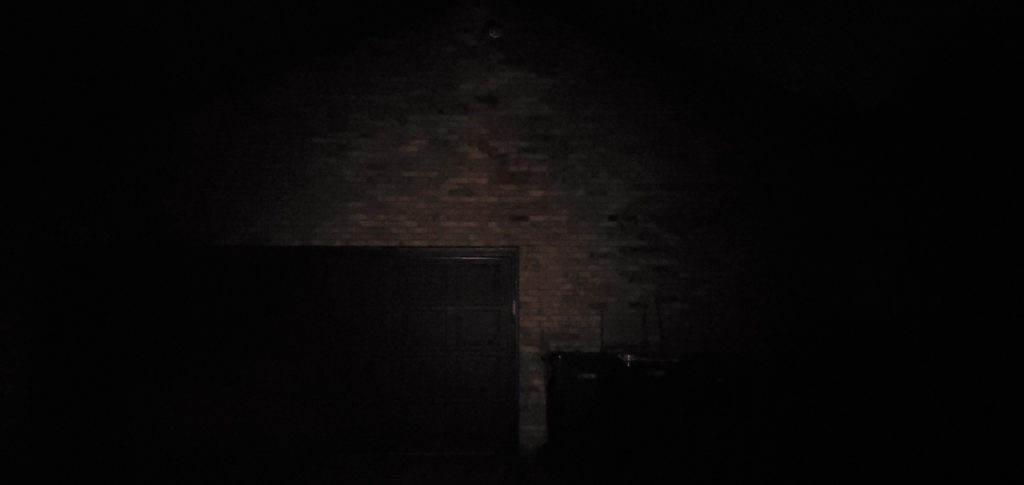
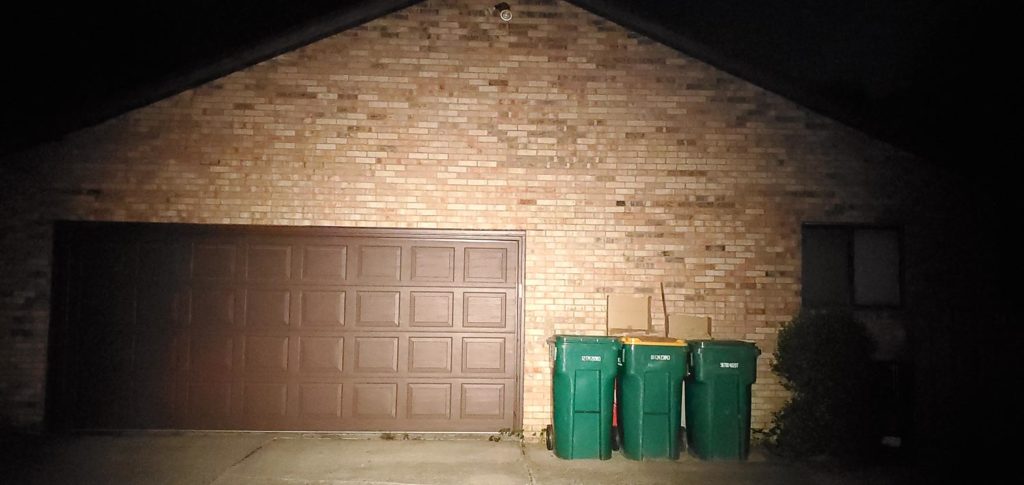
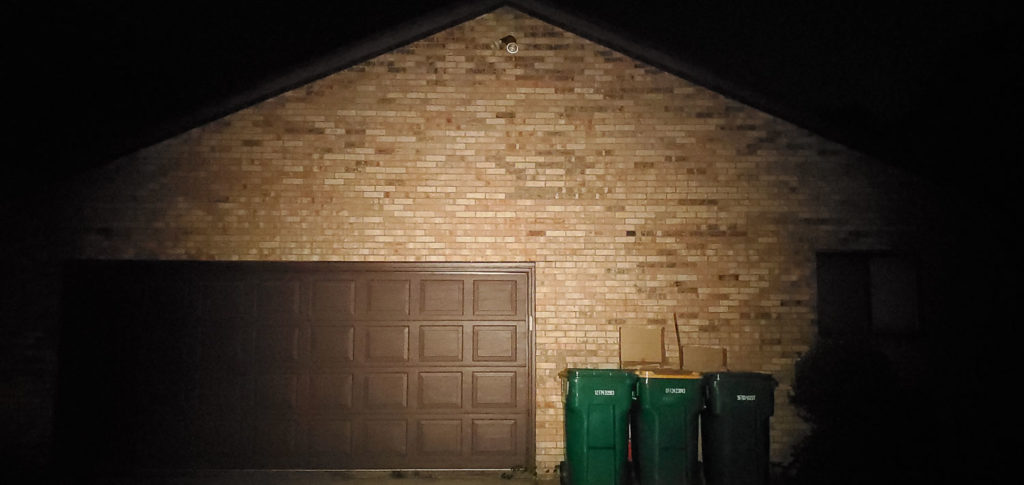
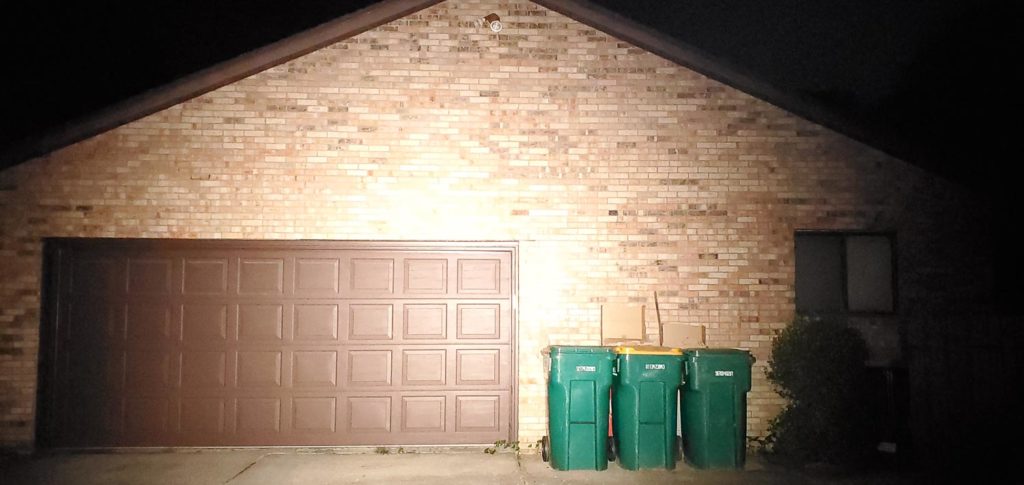
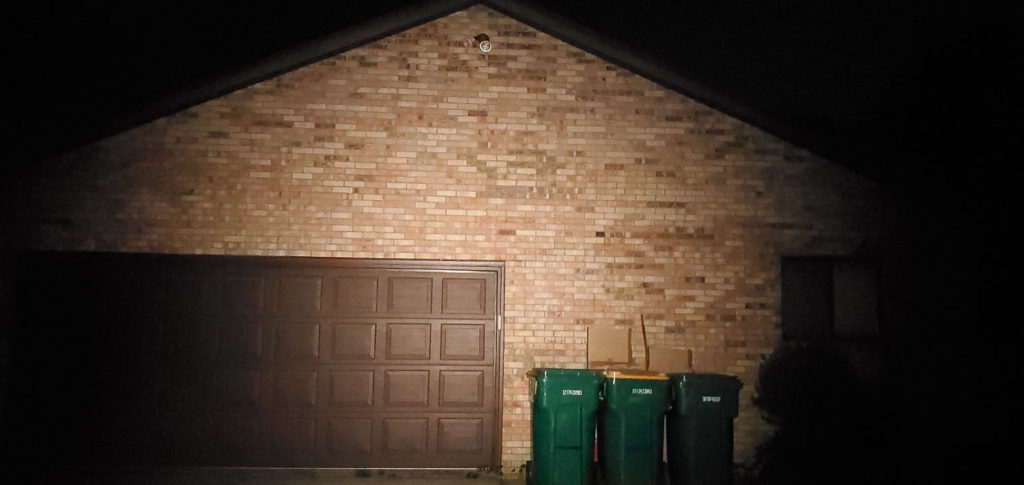
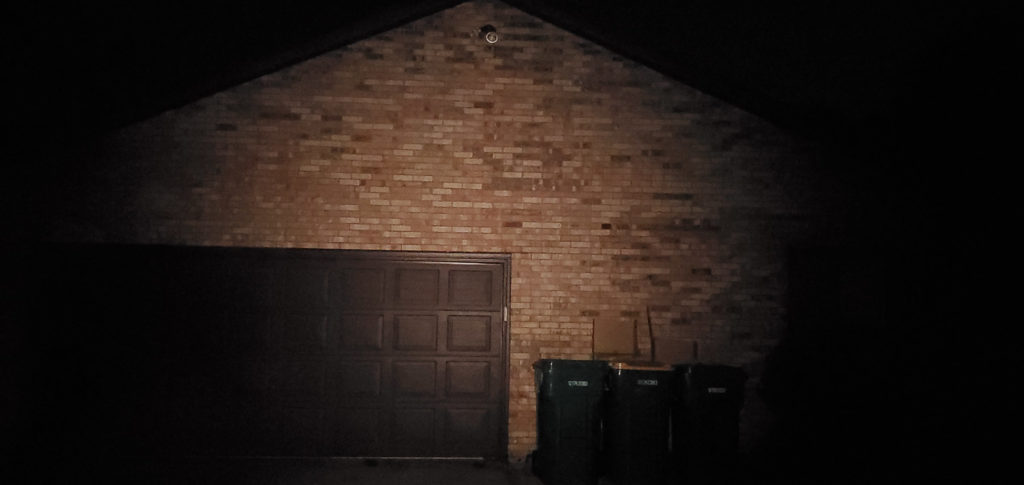
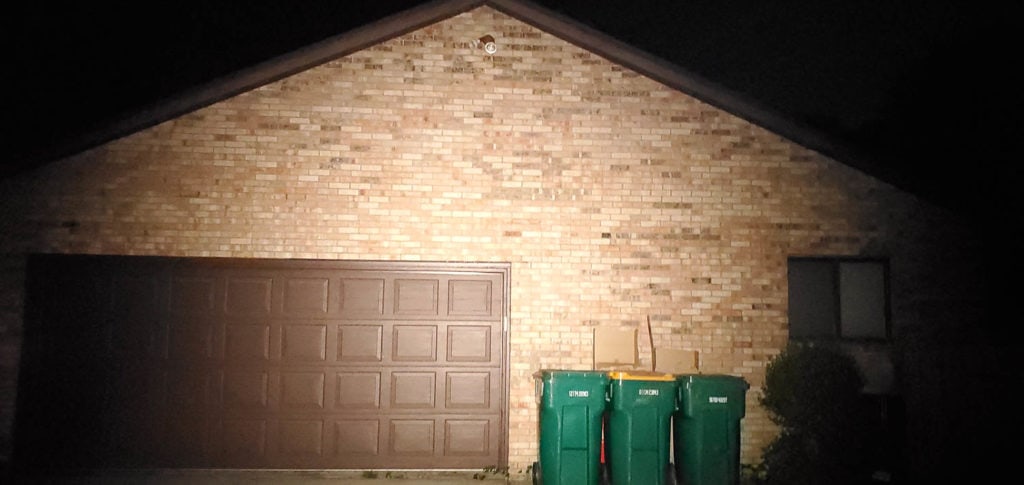
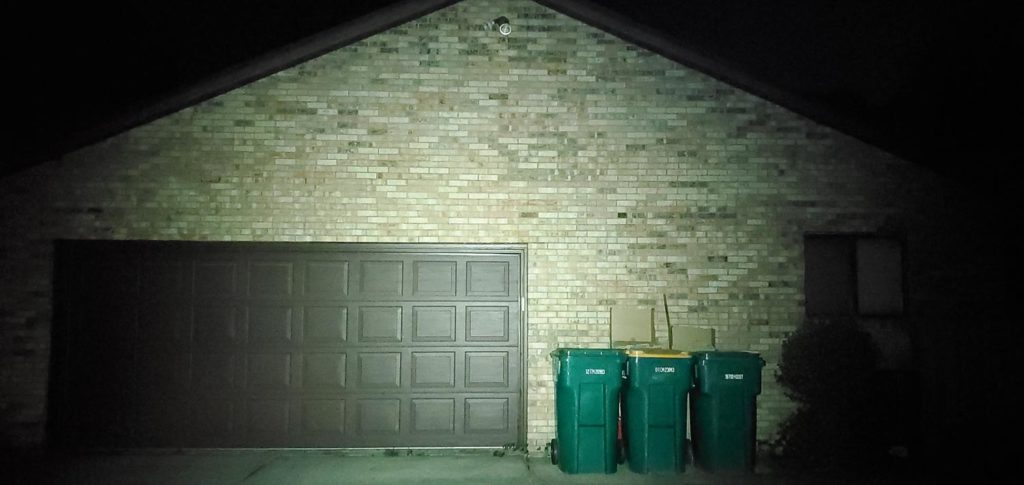
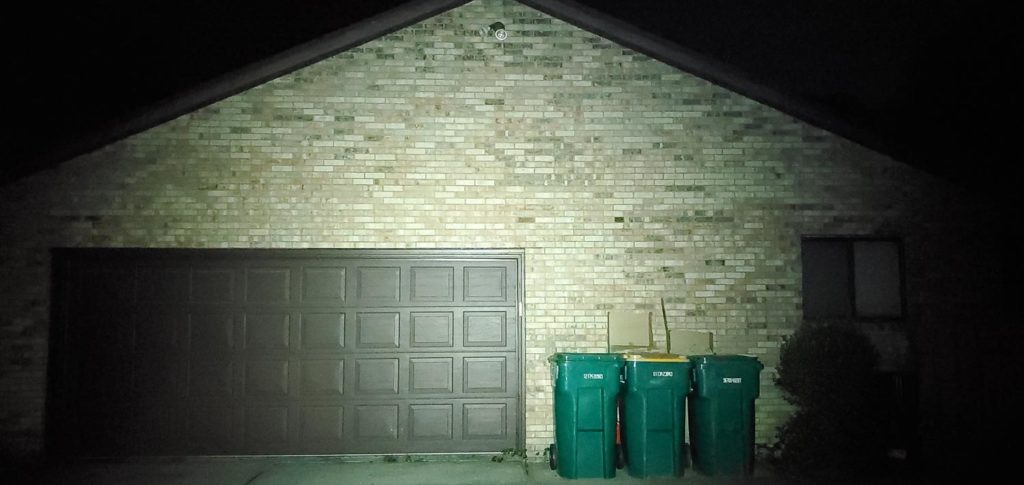
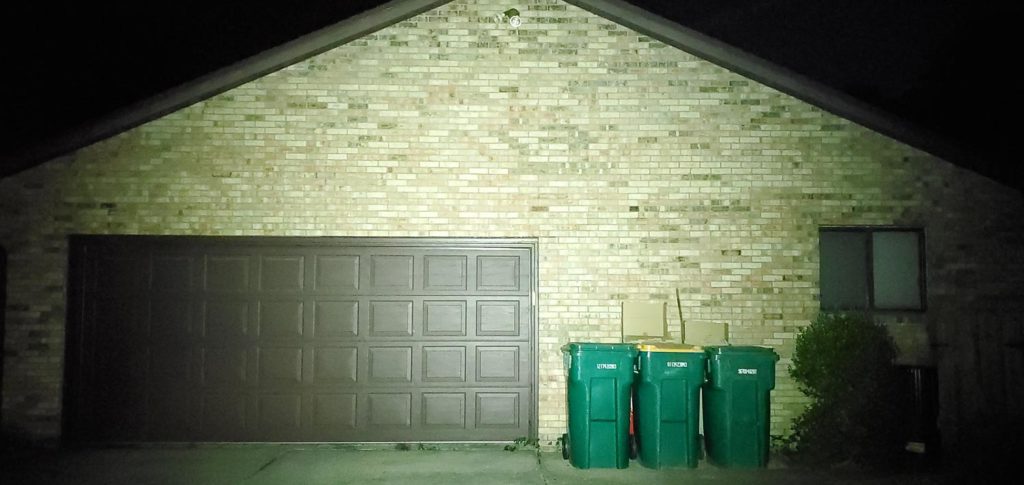
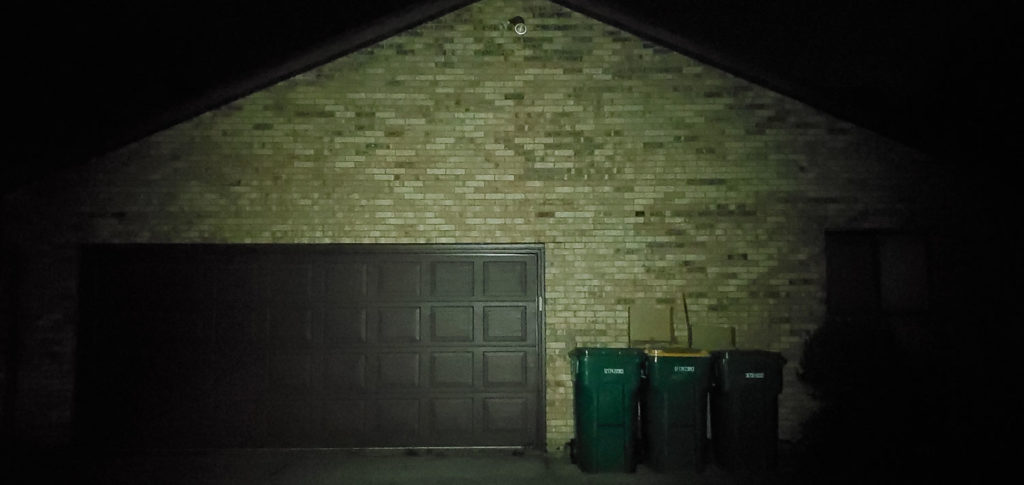
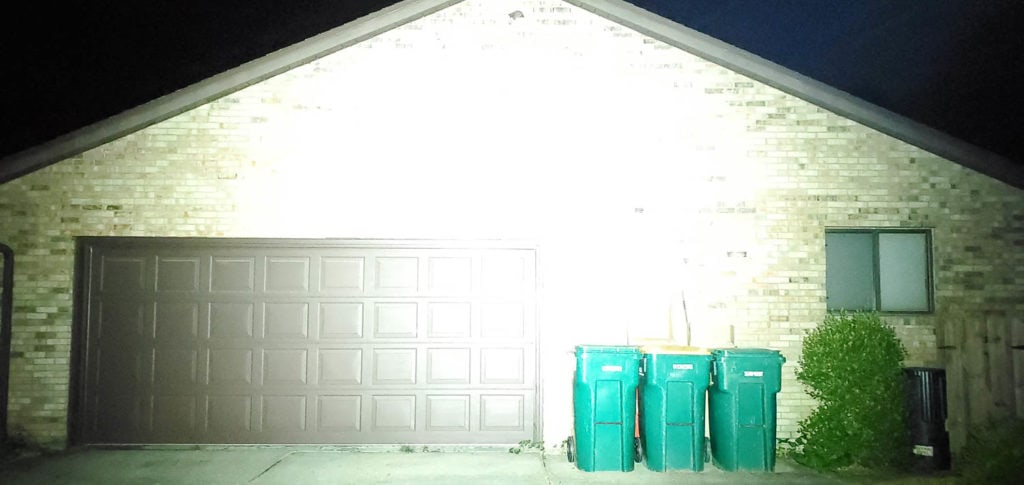
Disclaimer: I bought this flashlight with my own money. Nobody paid me to review this flashlight, nor have I been holding back on problems or defects.
Final Verdict
Pros
- Moonlight, moonlight, and more moonlight! The ultra-low Eco modes you get when using AAA batteries are excellent!
- Small enough to fit nearly anywhere; with the deep carry clip, disappears onto the side of your pocket
- Regulated output with AAA batteries means you always know what amount of light you’re getting
- The SST20 4000K is very nice to look at
Cons
- Horizontal-only knurling makes it slippery
- Having the button on top makes it easy to accidentally activate if it’s clipped to your pocket and not locked out
- With strobe being 3C and electronic lockout 4C, you end up accidentally in strobe when trying to lock it out.
- As of this writing, Manker is unable to produce more of the E02 II due to supply costs. Neutral white is almost impossible to find, but there are still many cool white versions out there.
Explanation on star ratings:
1: Avoid: my phone flashlight would be a better choice – 2: Poor: significant defect or issues; almost unusable – 3: Average: some defects or issues; but still usable 4: Good: recommended (minor issues) – 5: Great: highly recommended

5 stars: ★★★★★
The Manker E02 II is a little light with little output – and that’s a good thing! It’s one of the masters of moonlight with 6 (six!) moonlight modes (with AAA), 5 of which are sub-lumen! It can also hold its own against other AAA lights on higher modes, and if you really need a boost, drop in a 1044 lithium-ion battery for double the output. I rate the Manker E02 II five stars for its versatility as a small light.
Manker E02 II for sale
1lumen selects and reviews products personally. We may earn affiliate commissions through our links, which help support our testing.